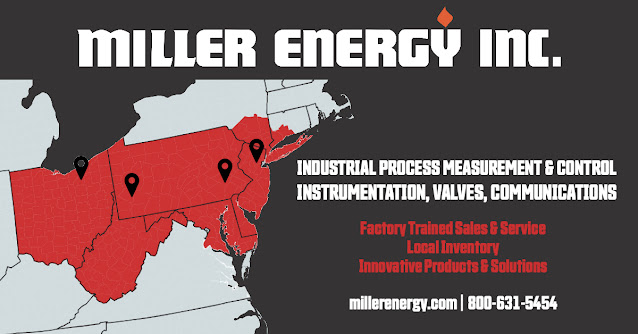A blog specializing in pressure, temperature, level and flow instrumentation, control valves, process analyzers, and all other areas of process measurement. Courtesy of Miller Energy, a New Jersey, New York, Pennsylvania, and Ohio process instrumentation Rep and Distributor.
Basics of Mass Flow Controllers (MFCs)
There are many applications for mass flow controllers (MFCs) in process control. Some examples include:
- Chemical processing: MFCs can be used to control the flow of reactants and catalysts in chemical reactions, ensuring consistent product quality and yield.
- Food and beverage processing: MFCs can be used to control the flow of ingredients in the production of beverages, sauces, and other food products.
- Pharmaceutical manufacturing: MFCs can be used to control the flow of active ingredients and excipients in the production of medications.
- Petrochemical processing: MFCs can be used to control the flow of fluids in the refining and processing of oil and natural gas.
- Environmental control: MFCs can be used to control the flow of gases and liquids in air pollution control systems, water treatment plants, and other environmental applications.
- Semiconductor manufacturing: MFCs can be used to control the flow of gases and liquids in the production of semiconductor devices.
- Aerospace and defense: MFCs can be used to control the flow of gases and liquids in a variety of aerospace and defense applications, including propulsion systems, life support systems, and fuel systems.
What is Refractometer Critical Angle Measurement?
On/Off Valves from Schubert & Salzer
Schubert & Salzer on/off valves are available in many configurations and sizes. Application solutions for almost any process are available using pneumatic or motorized actuators. Traditional globe pattern designs are available, as are angle globe seat valves with straight-through flow channels that reduce turbulence. All include a variety of end connections, including ANSI 150/300 flanges, threaded connections, tri-clamps, and weld ends. Valves provide millions of maintenance-free cycles in demanding applications such as steam, gaseous media, and contaminated liquids. Products include 316 stainless steel and bronze bodies, with actuator packages available in all stainless steel (including internals), heavy-duty metals, and lightweight plastics. Many features of motorized actuators include weather and water resistance, a variety of voltages, and fail-safe operation.
Angle seat valves:
Angle seat valves in the open/close or control designs have a particularly compact construction and can execute many switch cycles. In all of its variations, the valve's architecture provides a very efficient flow rate and can even install in mildly contaminated media.
Flange valves:
Flange valves are more accessible to remove from pipes than screwed valves at bigger diameters. This range fits various connection standards associated with angle and straight-flanged seat valves.
Three-way valves:
Three-way valves perform various activities, including mixing and distributing media flows and charging and discharging a functional component (e.g., a pressure cylinder).
For more information about Schubert & Salzer on/off products in NY, NJ, PA, DE, MD and OH contact Miller Energy, Inc. Call 800-631-5454 or visit https://millerenergy.com.
Brooks Instrument GP200 Pressure-based Mass Flow Controllers (MFC): Theory of Operation
- An upstream pressure transducer.
- An upstream control valve.
- Two individual pressure transducers.
- Laminar flow element.
GP200 FEATURES
- True differential pressure measurement
- Lower inlet pressure operation
- Downstream valve architecture
- Matched transient response
- Zero Leak-by Control Valve
- MultiFlo™ technology offers unparalleled flexibility—one device can be programmed for thousands of different gas and flow range configurations without removing the MFC from the gas line or compromising accuracy
- Local display indicates flow, temperature, pressure and network address
- DeviceNet™, EtherCAT®, RS-485 L-Protocol and analog interfaces
GP200 BENEFITS
- By removing the requirement to match and compensate two separate pressure transducers, the GP200 differential pressure technology reduces measurement uncertainty for enhanced accuracy, repeatability and drift performance.
- Safer fab operation at lower inlet pressures is now achievable with a P-MFC due to the GP200 differential pressure sensor that is specifically optimized for low differential pressure measurement.
- The downstream valve architecture ensures accuracy is independent of downstream pressure, enabling flow delivery into pressures as high as 1200 Torr. The fast closing valve addresses non-productive recipe wait times, or "tail effects," seen in upstream MFC valve designs that require additional time to bleed down their internal volume of gas.
- Ultra-fast, highly repeatable ascending and descending flow stabilization time enables tighter process control in advanced high cycle Deposition and Etch processes.
- 100X improvement in valve shut-down
- With MultiFlo™, MFC full scale flow range can be re-scaled down typically by a factor of 3:1 with no impact on accuracy, turndown or leak by specifications, for optimum process and inventory flexibility
- Convenient user display and independent diagnostic/service port aids device installation, monitoring and troubleshooting
Industrial Automated Ball Valves from Miller Energy
Phone: 800-631-5454
The Magnetrol-AMETEK Genesis™ Multiphase Detector
- Vapor phase
- Total level (e.g., hydrocarbon liquid)
- Top of the emulsion layer
- Bottom of emulsion layer (e.g., water level)
- Sediment
Schubert & Salzer Sliding Gate Control Valves from Miller Energy
6 Reasons to Choose Brooks SLA Series Mass Flow Controllers
- Options for star, ring, or daisy chain topologies.
- Operators can monitor real-time performance and network data by complying with IEEE Ethernet standards.
- Flexible network architecture compatible with ordinary Cat 5 cabling and routers simplifies network setup and guarantees all devices interact and exchange data.
- EtherNetIPTM and PROFINETTM enabled devices can provide rich data for process control, monitoring, diagnostics, and predictive maintenance.
Because EtherNet/IP™ and PROFINET use the Common Industrial Protocol (CIP™), support exists from a vast ecosystem of solution providers for industrial process automation. EtherNet/IP™ and PROFINET readily connect to a wide range of DCSs and PLCs, including:
- Allen-Bradley
- Emerson
- Siemens
- Rockwell
Due to the ability of contract manufacturers and end-users to use the EtherNet/IP™ and PROFINET protocols to:
- Cut operating costs
- Boost process efficiency, quality, yield, and output.
Brooks Instrument engineers worked with Rockwell Automation to provide an upgraded device profile that simplifies the setup and integration of the MFC into the Rockwell Automation (Allen-Bradley) PLC. The SLA5800 and SLAMf are now compatible with EtherNet/IP™ from renowned automation manufacturers.The upgraded device/add-on profile:
- Setup or edit any of the attribute tabs or parameters. The user determines which attributes are appropriate for their procedure.
- Removes the requirement for programming expertise to connect the MFC to the network.
On the SLA5800 and SLAMf with EtherNet/IP™ or PROFINET, we deliver on our promise to provide value without losing equipment space. Brooks Instrument designed EtherNet/IP™ and PROFINET directly into the mass flow controller, eliminating the need for add-on adapters or modules. The SLA5800 and SLAMf MFCs completely integrate EtherNet/IP™ and PROFINET. The EtherNet/IP™ or PROFINET equipped SLA5800 and SLAMf MFCs have the same footprint as the regular SLA5800 and SLAMf. They also link to your EtherNet/IP™ or PROFINET networks, eliminating the need for additional hardware such as gateways, analog I/O cards, or bespoke cabling and wires. All you need is standard ethernet wiring to get your device running and linked to the network.
The SLA5800 and SLAMf with EtherNet/IP™ or PROFINET have a user-friendly TCP/IP configuration. A web-based interface connects the MFC to the user's EtherNet/IP™ or PROFINET networks. Once on the network, the user can quickly identify individual MFCs, saving time if the system has several MFCs.
Intelligent and data-rich mass flow controllers, the SLA5800 and SLAMf with EtherNet/IP™ or PROFINET may improve operational efficiency in equipment automation, metrology, and maintenance.For example, limiting the upstream gas input pressure may affect MFC accuracy. The alarm data could be supplied to an operator via the built-in restricted flow alarm.
https://millerenergy.com
Miller Energy Is a Premier Manufacturer's Representative and Distributor of Process Instrumentation, Valves and Process Equipment
Miller Energy provides a wide range of instrumentation and control solutions to many markets, including refining, water treatment, chemical production, and food and beverage. Miller's products are useful in applications that require measuring, controlling, monitoring, and analyzing pressure, temperature, level, flow, pH, O2, CO2, and various other process variables.
Miller Energy comprises the most technically savvy salespeople in the industry. All Field Sales Engineers are factory trained on all of our product lines. All Inside Sales/Technical Support Engineers are responsible for a specific product line and support our entire customer base. Intelligent geographic product distribution provides the most timely delivery for greater customer satisfaction.
Miller Energy has four office locations:
- The South Plainfield, NJ, corporate headquarters serves Northern New Jersey, New York, and Fairfield County, Connecticut.
- The Exton, PA office serves Southern New Jersey, Eastern Pennsylvania, Delaware, and Maryland.
- The Pittsburgh, PA location serves Western Pennsylvania, Western Maryland, and West Virginia.
- The Cleveland, OH office serves Ohio.
Miller Energy, Inc.
In New York Metro and Northern NJ
Phone: 800-631-5454
In Eastern Pennsylvania and Delaware:
Phone: 610-363-6200
In Western Pennsylvania:
Phone: 412-257-0200
In Ohio:
Phone: 440-735-0100










